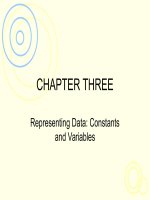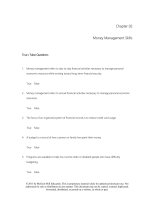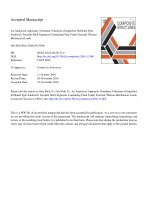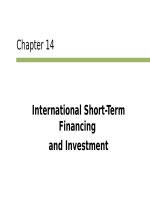Lecture International finance: An analytical approach (3/e): Chapter 3 - Imad A. Moosa
Bạn đang xem bản rút gọn của tài liệu. Xem và tải ngay bản đầy đủ của tài liệu tại đây (595.43 KB, 36 trang )
Chapter 3
The Balance of Payments and the
Effective Exchange Rate
Objectives
• To study the structure of the balance of payments
• To illustrate how the BOP is related to the FX market
• To introduce the concept of the effective exchange
rate
Copyright 2010 McGraw-Hill Australia Pty Ltd
PPTs t/a International Finance: An Analytical Approach 3e by Imad A. Moosa
Slides prepared by Afaf Moosa
3-2
Definition
• The balance of payments (BOP) is a systematic
record of all economic transactions between the
residents of the reporting country and the rest of the
world over a specified period of time.
Copyright 2010 McGraw-Hill Australia Pty Ltd
PPTs t/a International Finance: An Analytical Approach 3e by Imad A. Moosa
Slides prepared by Afaf Moosa
3-3
Important elements in the
definition
•
•
•
•
Rest of the world
Economic transactions
Resident
Flows versus stocks
Copyright 2010 McGraw-Hill Australia Pty Ltd
PPTs t/a International Finance: An Analytical Approach 3e by Imad A. Moosa
Slides prepared by Afaf Moosa
3-4
Important elements in the
definition (cont.)
• The BOP records changes in assets and liabilities
• Figures may or may not be seasonably adjusted
Copyright 2010 McGraw-Hill Australia Pty Ltd
PPTs t/a International Finance: An Analytical Approach 3e by Imad A. Moosa
Slides prepared by Afaf Moosa
3-5
Structure of the BOP
• The BOP consists of the current account and the
financial account
Copyright 2010 McGraw-Hill Australia Pty Ltd
PPTs t/a International Finance: An Analytical Approach 3e by Imad A. Moosa
Slides prepared by Afaf Moosa
3-6
Components of the current account
• Merchandise account (trade balance)
• Net services
• Current transfers
Copyright 2010 McGraw-Hill Australia Pty Ltd
PPTs t/a International Finance: An Analytical Approach 3e by Imad A. Moosa
Slides prepared by Afaf Moosa
3-7
The financial account
• Records official and non-official net financial flows
• A balancing item is added to account for errors and
omissions
Copyright 2010 McGraw-Hill Australia Pty Ltd
PPTs t/a International Finance: An Analytical Approach 3e by Imad A. Moosa
Slides prepared by Afaf Moosa
3-8
The Australian BOP: Current
account
(AUD Million)
Copyright 2010 McGraw-Hill Australia Pty Ltd
PPTs t/a International Finance: An Analytical Approach 3e by Imad A. Moosa
Slides prepared by Afaf Moosa
3-9
The Australian BOP: Financial
account
(AUD Million)
Copyright 2010 McGraw-Hill Australia Pty Ltd
PPTs t/a International Finance: An Analytical Approach 3e by Imad A. Moosa
Slides prepared by Afaf Moosa
3-10
The Australian BOP: Balancing item
(AUD Million)
Copyright 2010 McGraw-Hill Australia Pty Ltd
PPTs t/a International Finance: An Analytical Approach 3e by Imad A. Moosa
Slides prepared by Afaf Moosa
3-11
The BOP and FX market
• The BOP is related to the FX market because
transactions involving trade and capital flows give
rise to the demand for and supply of currencies
• The demand for foreign currency is the supply of
domestic currency, and vice versa
Copyright 2010 McGraw-Hill Australia Pty Ltd
PPTs t/a International Finance: An Analytical Approach 3e by Imad A. Moosa
Slides prepared by Afaf Moosa
3-12
Derivation of the demand and
supply curves
• The demand for foreign exchange is equivalent to
import expenditure
• The demand curve is derived from the supply and
demand for imports
(cont.)
Copyright 2010 McGraw-Hill Australia Pty Ltd
PPTs t/a International Finance: An Analytical Approach 3e by Imad A. Moosa
Slides prepared by Afaf Moosa
3-13
Derivation of the demand and
supply curves (cont.)
• The supply of foreign exchange is equivalent to
export revenue.
• The supply curve is derived from the supply of and
demand for exports.
Copyright 2010 McGraw-Hill Australia Pty Ltd
PPTs t/a International Finance: An Analytical Approach 3e by Imad A. Moosa
Slides prepared by Afaf Moosa
3-14
The demand side equations
The following equations are used to derive the demand
curve:
*
m
Df
P Qm
Qm
a bPm
Pm
SPm*
Copyright 2010 McGraw-Hill Australia Pty Ltd
PPTs t/a International Finance: An Analytical Approach 3e by Imad A. Moosa
Slides prepared by Afaf Moosa
3-15
The supply side equations
The following equations are used to derive the supply
curve:
Sf
Px* Qx
Qx
c dPx
*
Px
Px
S
Copyright 2010 McGraw-Hill Australia Pty Ltd
PPTs t/a International Finance: An Analytical Approach 3e by Imad A. Moosa
Slides prepared by Afaf Moosa
3-16
The demand for and supply of
foreign exchange curves
Copyright 2010 McGraw-Hill Australia Pty Ltd
PPTs t/a International Finance: An Analytical Approach 3e by Imad A. Moosa
Slides prepared by Afaf Moosa
3-17
Factors affecting the current
account
• Economic growth: A country with a higher growth
rate than its trading partners will experience
deterioration in the current account.
(cont.)
Copyright 2010 McGraw-Hill Australia Pty Ltd
PPTs t/a International Finance: An Analytical Approach 3e by Imad A. Moosa
Slides prepared by Afaf Moosa
3-18
Factors affecting the current
account (cont.)
• The exchange rate: The effect of the exchange rate
depends on the elasticities of demand for exports
and imports.
*
*
Px Qx
Q m
em Pm
Q x
*
e x Px
B
*
PmQm
Copyright 2010 McGraw-Hill Australia Pty Ltd
PPTs t/a International Finance: An Analytical Approach 3e by Imad A. Moosa
Slides prepared by Afaf Moosa
(cont.)
3-19
Factors affecting the current
account (cont.)
• Inflation: A country that has a higher inflation rate
than its trading partners will experience deterioration
in the current account.
(cont.)
Copyright 2010 McGraw-Hill Australia Pty Ltd
PPTs t/a International Finance: An Analytical Approach 3e by Imad A. Moosa
Slides prepared by Afaf Moosa
3-20
Improving current account
(zero domestic inflation)
50
40
30
20
10
0
-10
1
2
3
4
5
6
7
8
9
10
11
-20
-30
-40
-50
Copyright 2010 McGraw-Hill Australia Pty Ltd
PPTs t/a International Finance: An Analytical Approach 3e by Imad A. Moosa
Slides prepared by Afaf Moosa
3-21
Deteriorating current account
(high domestic inflation)
0
1
2
3
4
5
6
7
8
9
10
11
-40
-80
-120
-160
-200
Copyright 2010 McGraw-Hill Australia Pty Ltd
PPTs t/a International Finance: An Analytical Approach 3e by Imad A. Moosa
Slides prepared by Afaf Moosa
3-22
Factors affecting the current
account (cont.)
• Trade restrictions: One reason for imposing trade
restrictions, such as tariffs and quotas, is the desire
to protect the current account.
Copyright 2010 McGraw-Hill Australia Pty Ltd
PPTs t/a International Finance: An Analytical Approach 3e by Imad A. Moosa
Slides prepared by Afaf Moosa
3-23
Factors affecting the financial
account
• Taxes: Taxes that are imposed on capital gains
and/or income from dividends and interest payments
may adversely affect the financial account. This is
because foreign investors no longer find it attractive
to invest in the underlying country’s securities.
(cont.)
Copyright 2010 McGraw-Hill Australia Pty Ltd
PPTs t/a International Finance: An Analytical Approach 3e by Imad A. Moosa
Slides prepared by Afaf Moosa
3-24
Factors affecting the financial
account (cont.)
• Capital controls: Capital controls are imposed
typically to deal with a chronic weakness in the
balance of payments.
(cont.)
Copyright 2010 McGraw-Hill Australia Pty Ltd
PPTs t/a International Finance: An Analytical Approach 3e by Imad A. Moosa
Slides prepared by Afaf Moosa
3-25









